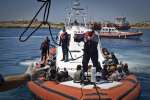High seas tragedies leave more than 300 dead on the Mediterranean in past week
News Stories, 26 August 2014
GENEVA, August 26 (UNHCR) – More than 300 people have died while trying to make irregular sea crossings from North Africa to Europe in the past week, bringing the death toll this year from sinking vesels on the Mediterranean to almost 1,900, including some 1,600 since June.
"The past few days have been the deadliest this year on the Mediterranean for people making irregular crossings to Europe, with at least three vessels having overturned or sunk," UNHCR's senior spokesperson, Melissa Fleming, told journalists in Geneva.
She said the first and largest of these incidents occurred last Friday when a boat, reportedly carrying at least 270 people, capsized near Garibouli to the east of the Libyan capital, Tripoli. Nineteen people survived, but the Libyan coastguard has recovered the bodies of 100 others, including five young children and seven women. The remaining 251 passengers are feared drowned.
Citing reports from survivors, Fleming said "the boat was packed full and more people were pushed on board before they departed. According to the accounts, the boat suddenly flipped, trapping the people on the lower deck." The Libyan coastguard has asked for help in the search and rescue operation and to recover bodies.
In a second incident on Saturday evening, the Italian Navy rescued 73 people and recovered 18 bodies from a damaged rubber dinghy 20 miles from Libyan territorial waters. UNHCR's Fleming said 10 people were still missing and feared drowned.
The passengers were mainly from Mali, Côte d'Ivoire, Guinea and Sudan. The dinghy was already partially deflated when spotted by an Italian search and rescue aircraft and life rafts were dropped to people struggling in the water.
In a third incident, on Sunday evening, a fishing boat carrying about 400 people capsized north of the Libyan coast in bad weather. The Italian Navy and coastguard, in a joint operation with a nearby merchant ship, rescued 364 people. So far, 24 bodies have been recovered and more are feared dead. The exact number of missing is not yet confirmed.
The main departure country for Europe is Libya, where the worsening security situation has fostered the growth of people smuggling operations, but also encouraged refugees and migrants to risk the sea journey rather than remain in a conflict zone.
"UNHCR's Tripoli office receives daily calls from refugees, asylum-seekers and other vulnerable people expressing fear for their lives and making desperate requests for food, water, medicine and relocation. Those who choose to leave for Italy are taking longer and riskier journeys through new ports of departure such as Benghazi [in eastern Libya]," Fleming said.
She noted that many of those risking their lives at sea to reach Europe were refugees fleeing conflict, violence and persecution. "This dramatic situation at Europe's sea borders demands urgent and concerted European action, including strengthened search-and-rescue operations in the Mediterranean, ensuring that rescue measures are safe and incur minimum risks for those being rescued," she added.
"UNHCR commends the life-saving Mare Nostrum (Our Sea) operation the Italian Navy and coastguard is conducting that has saved thousands of lives. As more refugees and migrants risk their lives at sea to reach Europe, mostly Eritreans, Syrians, and Somalis, urgent action is needed," Fleming stressed.
The UN refugee agency believes that it is of vital importance that survivors of these tragedies, who often have lost family and friends, be given immediate access to psychological support once they are disembarked. UNHCR has also called for procedures to be put in place to allow for identification of the bodies recovered at sea, providing quick and clear information so that families are not subjected to unnecessary additional suffering.


















































